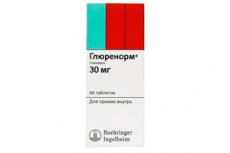該文的醫學專家
新出版物
Glurenorm
阿列克谢·克里文科,医学审稿人
最近審查:04.07.2025
最近審查:04.07.2025

格列诺酮(活性成分:格列喹酮)是一种磺酰脲类口服降糖药。当饮食、运动和减肥无法有效控制血糖水平时,可使用格列诺酮治疗2型糖尿病。
格列喹酮刺激胰腺产生胰岛素,从而降低血糖水平。与同类药物不同,格列喹酮半衰期较短,起效迅速,能够更有效地控制餐后血糖水平。
格列诺酮通常作为2型糖尿病综合治疗方案的一部分,该方案还包括改变饮食和运动等生活方式。如果格列喹酮单药治疗无法达到目标血糖水平,该药物可以单独使用,也可以与其他降糖药联合使用。
適應症 Glurenorma
Glurenorm 用于治疗 2 型糖尿病,特别是在饮食和体力活动不足以达到正常血糖水平的情况下。
發布表單
Glurenorm 有口服片剂形式。
藥效學
- 胰岛素刺激:Glurenorm 通过刺激胰腺 β 细胞释放胰岛素发挥作用。它通过与 β 细胞表面受体结合,增加其对钾离子的通透性,从而导致细胞去极化并释放胰岛素。
- 增强胰岛素敏感性:Glurenorm 还能提高组织对胰岛素的敏感性,使其能够更有效地利用血液中的葡萄糖。这对肌肉和脂肪组织尤其重要。
- 增加外周葡萄糖吸收:除了刺激胰岛素释放外,格列喹酮还促进组织增加外周葡萄糖吸收,进一步降低血糖水平。
- 糖异生减少:Gluronorm 还可能减少肝脏中的葡萄糖生成(糖异生),导致血糖水平降低。
- 纠正餐后高血糖:格列喹酮通过增加胰岛素对碳水化合物的反应来帮助降低餐后血糖水平(餐后高血糖)。
藥代動力學
- 吸收:口服后,格列喹酮通常从胃肠道迅速、完全地吸收。
- 分布:格列喹酮吸收后迅速分布于体内,并与血浆蛋白大量结合。
- 代谢:格列喹酮在肝脏中代谢,主要通过氧化和葡萄糖醛酸化进行转化。
- 排泄:格列喹酮代谢物和未代谢药物主要经肾脏排泄。格列喹酮在血液中的半衰期约为5-7小时。
- 影响药代动力学的因素:老年患者或肾功能不全患者中,格列喹酮的半衰期可能会延长。此外,还需考虑格列喹酮与其他药物的潜在相互作用,这些药物可能会影响格列喹酮在体内的代谢和消除。
劑量和管理
使用方法:
- 与食物同服:格鲁诺姆通常在餐前30分钟口服。这对于药物的疗效至关重要,因为它可以在食物进入胃部时刺激胰岛素的产生。
- 服药规律:应按照医生制定的时间表定期服用药物,以确保血糖水平的稳定控制。
剂量:
Gluronorm 的剂量可能因个体患者的需求、对治疗的反应和目标血糖水平而异。
- 初始剂量:通常从每天一次 30 毫克格列喹酮开始。
- 剂量调整:可根据患者的血糖反应逐渐增加剂量。通常每隔数周增加一次剂量。
- 维持剂量:通常的维持剂量为每天30-120毫克。每日剂量不应超过120毫克。
- 最大剂量:允许的最大剂量为每天 120 毫克。
在懷孕期間使用 Glurenorma
一般信息:
- 与其他磺酰脲类药物一样,格列喹酮不建议在怀孕期间使用。这类药物可能导致低血糖,对母亲和胎儿都构成风险。
- 动物研究表明该药物对胎儿存在一定风险,但关于人类怀孕期间使用格列喹酮的安全性的完整临床数据尚缺乏。
对胎儿的风险:
- 磺酰脲类药物,包括格列喹酮,可以穿过胎盘,可能导致新生儿低血糖,需要在出生后进行密切的医疗监督。
治疗方案:
- 在妊娠期间,胰岛素通常被推荐用于糖尿病管理,因为它不会穿过胎盘,也不会对胎儿造成低血糖风险。胰岛素被认为是治疗妊娠期糖尿病的黄金标准。
禁忌
- 1 型糖尿病:Glurenorm 禁用于治疗 1 型糖尿病,该病的特征是体内完全或几乎完全缺乏胰岛素。
- 酮症酸中毒:如果出现酮症酸中毒,则禁用 Glurenorm。酮症酸中毒是糖尿病的一种严重并发症,其特征是血液中酮体含量高。
- 肝功能损害:对于严重肝功能损害的患者,可能禁用 Gluronorm,因为这可能会损害格列喹酮的代谢和消除。
- 肾功能不全:Glurenorm 通过肾脏排泄,因此严重肾功能不全的患者可能禁用。
- 怀孕和哺乳:关于格列喹酮在怀孕和哺乳期间的安全性的数据有限,因此在这种情况下使用需要特别注意并咨询医生。
- 过敏:已知对格列喹酮或该药物的其他成分过敏的患者应避免使用。
副作用 Glurenorma
Glurenorm(格列喹酮)的副作用可能包括低血糖、恶心、呕吐、腹泻、低血糖昏迷、过敏反应(包括荨麻疹、瘙痒和皮疹)以及肝酶升高。
過量
- 低血糖:过量服用格列喹酮会导致血糖水平大幅下降,并可能引发各种低血糖症状,包括饥饿、颤抖、出汗、虚弱、低血压、意识模糊、癫痫发作,甚至失去意识。如果发生低血糖,必须立即采取措施恢复血糖水平。
- 低血糖症的治疗:格列喹酮过量后出现的低血糖症的治疗包括:先服用速效碳水化合物,例如果汁、葡萄糖或含糖饮料,然后再服用慢效碳水化合物,以防止低血糖症复发。在严重病例中,可能需要静脉注射葡萄糖,并在病情稳定后监测一段时间的血糖水平。
- 医疗护理:如果您怀疑服用过量格列喹酮,请立即就医。医生可以采取必要的医疗措施,例如强化葡萄糖或胰岛素治疗,以使血糖水平恢复正常。
與其他藥物的相互作用
- 水杨酸盐:增强格列喹酮的降血糖作用。
- 磺酰脲类(SUL)及其衍生物:可能会增强格列净的降血糖作用。
- 抗菌剂:某些抗生素(例如磺胺类药物、四环素类药物)和抗真菌药物可能会增强格列酮的降血糖作用。
- β受体阻滞剂:掩盖低血糖症状,如心动过速和出汗。
- 含酒精的药物:与酒精的相互作用可能会增强格列酮的降血糖作用。
- 影响肾功能的药物:格列奎酮的半衰期增加,可能需要调整剂量。
- 影响肝功能的药物:葡萄糖酸喹酮代谢受损,血液中葡萄糖酸喹酮浓度升高。
- 其他降血糖药:一起使用时会增加低血糖的风险。
注意!
為了簡化對信息的理解,本指令使用了藥物 "Glurenorm",並根據藥物的醫療用途官方說明。 使用前請閱讀直接用於藥物的註釋。
描述僅供參考,不適用於自我修復指導。 這種藥物的需求,治療方案的目的,藥物的方法和劑量僅由主治醫師確定。 自我藥療對你的健康有危害。


